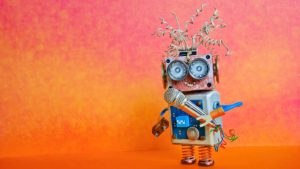A.I. Generated Humor
The use of artificial intelligence (A.I.) is rapidly increasing in a variety of different industries. A.I. is most commonly associated with jobs such as analyzing algorithms, sorting through big data, or doing a host of other important tasks. In actuality, however, A.I. can be applied to almost everything, even making jokes.
How Funny Is It?
The jokes made by these A.I. ‘s are better than, or as good as, than jokes that humans make. In order to confirm this, Harvard ran researchers conducted a series of experiments, in which they approached 1000 random people and told each of them a joke generated by A.I. and a joke created by a human. Shockingly, they found that people laughed at the jokes made by the A.I. approximately 4% more often than the jokes made by humans. This difference may be small, but it demonstrates the power and potential of A.I. The power of A.I. can be channeled in different ways as there are a variety of different joke telling A.I. and all of them work to a varying degree. These joke telling A.I. also tell these jokes in a variety of formats, from corny dad jokes to “Yo mama” jokes offering a way to make anyone with any sense of humor laugh.
 Graphic of computers telling jokes
Graphic of computers telling jokes
Source: Towards Data Science
The Logic of Jokes
Although it seems like writing jokes may require emotion, there is actually a logical way to create them. Most jokes have the core parts of the set-up and the punchline. In the set-up, as the name implies, you set up the joke and prepare it for the punchline. The punchline is what makes the joke funny, and it is often an unexpected retort or response. It could also be a misjudgment of the situation. Both of these things can be automated by utilizing an algorithm, which is what led to the building of various A.I. and algorithms.
How Was It Made?
All modern day A.I. use machine learning—the use of algorithms and data to solve problems—to solve whatever task they are given. In the case of humor, the A.I. is first given a variety of jokes that are considered funny. Using algorithms to manipulate this data, the A.I. figures out what makes the jokes funny, and is able to recreate these jokes and others like them, using similar set-ups and punchlines. The one problem with machine learning is we don’t know how the machine determines things and is able to recreate it. In the example of humor, we don’t know what the computer thinks makes the joke funny. We simply get the output of the program. With all machine learning, we give the A.I. input and receive and output, however we don’t know what happens in between, as these programs go through so much data at an extremely fast rate, and it would be impossible for a human to do the same thing. Humans can however create an abstraction, or basic rundown, of what the program does.
How Does It Work?
Joe Toplyn, the creator of Witscript, explains the process. First, the program chooses a topic and an attention grabber from its database. Then, it creates a punchline, finds a bridge from the joke to the punchline, and delivers it. However, the A.I. doesn’t do all of this by itself; it outsources different parts of this process to be handled by other existing algorithms. To test Witscript, Toplyn inputted 13 different topics into the algorithm. This resulted in a variety of different jokes, all humorous to him and those he asked.

Robot Generated Humor
Source: ifscience.com
The Future With A.I.
As Joe says, “A.I. and A.I. generated humor still has a long way to go and will eventually be applied to everything”. Almost everything can be done faster and more efficiently with the use of A.I., and humor is just the start. Humor, something that is usually made by humans, can be easily made by A.I. showing its ability to possibly replace humans need to be funny. One day, A.I. might be able to write entire movies, shows and do so much more than humans can, in less time than humans can. A.I. is the future and humor is just one major stepping stone in its journey.
References and Sources
Ampil, L. (2020, January 25). Can a robot make you laugh? - teaching an AI to tell jokes.
Medium. Retrieved November 21, 2021, from https://towardsdatascience.com/can-a-robot-make-you-laugh-teaching-an-ai-to-tell-jokes-815f1e1e689c.
By: IBM Cloud Education. (2020). What is machine learning? IBM. Retrieved November 21,
2021, from https://www.ibm.com/cloud/learn/machine-learning.
Dormehl, L. (2021, November 8). Why machine-generated humor is the holy grail of A.I. Digital
Trends. Retrieved November 21, 2021, from https://www.digitaltrends.com/computing/ai-humor-jokes-holy-grail-machine-intelligence/.
Gerderman, D. (2019, November 20). It’s no joke: Ai Beats humans at making you laugh.
HBS. Working Knowledge. Retrieved November 21, 2021, from https://hbswk.hbs.edu/item/it-s-no-joke-ai-beats-humans-at-making-you-laugh.